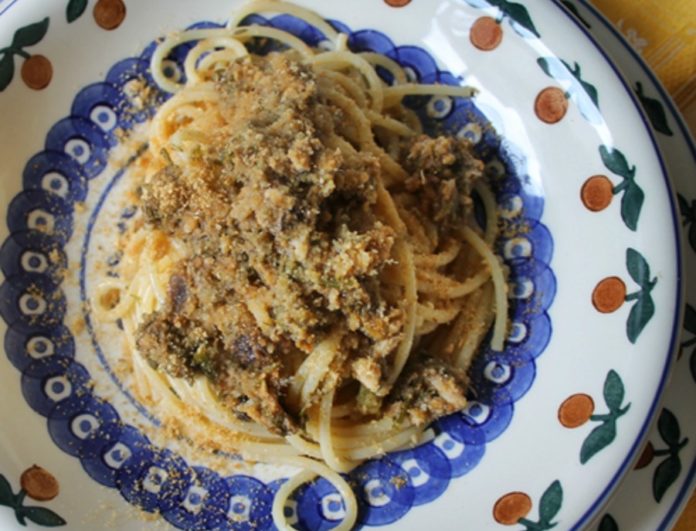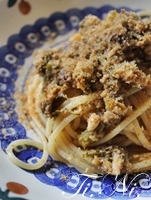 The “pasta chi saiddi“, pasta with sardines, and its many versions: from poor dish to deceit, from sea taste to flavour of field harvesting, to wild encounter for that wild fennel which in a good part of the globe is not even picked up. In Palermo instead it’s history, poverty in the pocket and richness in heart, it’s a pasta dish which in the festivity of S. Joseph is a must at table and for the rest of the year is greedily awaited for (Ti.Ni.)
The “pasta chi saiddi“, pasta with sardines, and its many versions: from poor dish to deceit, from sea taste to flavour of field harvesting, to wild encounter for that wild fennel which in a good part of the globe is not even picked up. In Palermo instead it’s history, poverty in the pocket and richness in heart, it’s a pasta dish which in the festivity of S. Joseph is a must at table and for the rest of the year is greedily awaited for (Ti.Ni.)
it’s a characteristic dish, typically served on Sicilian tables, with the awareness that not always what’s good is expensive. What to do when fresh sardines are not available, or you don’t have enough money to buy fish and other food? A native of Palermo, in the XVIII century as well as today does his best to to cut a fine figure, because to show off at the table means displaying wealth, and showing off is law in a tradition where dirty linen mustn’t be washed in public. 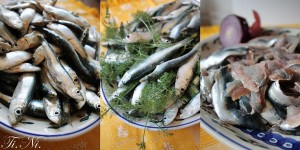 It’s a poor dish, though today is included in the menus of restaurants with resounding names patronized by well dressed men and jeweled women.
It’s a poor dish, though today is included in the menus of restaurants with resounding names patronized by well dressed men and jeweled women.
This pasta has old roots and always new tastes, every house adapts it to the needs of time, taste and expenses. And it becomes “pasta ca’nciovi”, because anchovies are used instead of sardines and wild fennel. It becomes “pasta ca’ munnizza” (pasta with garbage, lovingly called so, in Catania and Messina, due to the scarceness of substance) when sardines are not used at all, and remain in the sea, and wild fennel is the only protagonist.
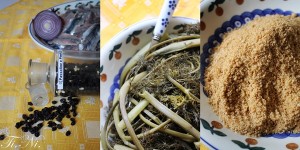 Raisins and pine seeds, a sweet and sour ingredient brought to the island during the Arab domination, are the classic flavour that is essential to this type of cookery. Wild fennel grows on the border of cultivated fields, for whoever has never tried its essence it’s scrap. Sardines are food for other fishes, sometimes they are even thrown back in the sea by the fishermen because of the poverty they seem to bring, they are believed to be fat and little pleasant by those palates which are not used to saltiness. Yet, the mixture of these poor elements ratify a pact which has been lasting for many many years multiplying time – as Jesus did with bread and fish – in inventing food from the little or less ingredients available.
Raisins and pine seeds, a sweet and sour ingredient brought to the island during the Arab domination, are the classic flavour that is essential to this type of cookery. Wild fennel grows on the border of cultivated fields, for whoever has never tried its essence it’s scrap. Sardines are food for other fishes, sometimes they are even thrown back in the sea by the fishermen because of the poverty they seem to bring, they are believed to be fat and little pleasant by those palates which are not used to saltiness. Yet, the mixture of these poor elements ratify a pact which has been lasting for many many years multiplying time – as Jesus did with bread and fish – in inventing food from the little or less ingredients available.
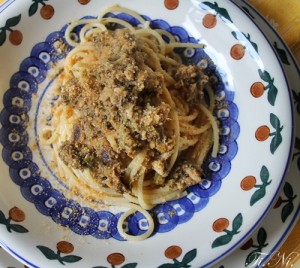 Wild fennel was already known in ancient Rome, Apicio supposedly used it to flavour fish and this trick has not waned, and the seeds of the plant entered the cookery, the Sicilian one at the maximum extent, to season other food. We are talking about seized fennel seeds, a spice which is useful from a herbal standpoint in stimulating digestion. These seeds are used in the condiment of sausages and at times in bread or in some biscuits.
Wild fennel was already known in ancient Rome, Apicio supposedly used it to flavour fish and this trick has not waned, and the seeds of the plant entered the cookery, the Sicilian one at the maximum extent, to season other food. We are talking about seized fennel seeds, a spice which is useful from a herbal standpoint in stimulating digestion. These seeds are used in the condiment of sausages and at times in bread or in some biscuits.
Including fish, vegetables, fruit, pasta and breadcrumbs, this food proves to be complete and balanced. It’s a pasta which was born within the walls of a city overlooking the sea – Palermo – and transforms itself following the current needs and still lives, because it is extremely versatile in the fact that it can be enjoyed hot, warm of cold, or baked in the oven whenever any of it is left. When sardines arrive, with the catch, they are “allinguate” i.e. filleted thus eliminating the fish bone, they are drawn to the rest of the crew and left in that well known condiment. If they completely lack, the pasta becomes with the sardines left in the sea and the wild fennel will lord it replacing the absence of the fish in the taste. But as a general rule every islander larder holds inside a jar of sardines in oil, some concentrated tomato paste, the basic ingredients and all that follows will be a gravy to be used with long pasta, if not “bucatini” (large hollow spaghetti), macaroni, “ziti” (short macaroni) or linguine, thus giving life to the even more cheap version of a “pasta ca’nciovi”.
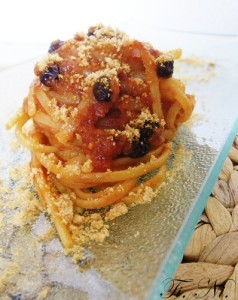 In the shopping basket:
In the shopping basket:
250 g of Linguine
4 Filets of Anchovies in oil
50 g of Concentrated Tomato paste
1 Garlic clove
1 spoon of Raisins and pine seeds
2 spoons of Breadcrumbs
New Oil, Salt and ground Black Pepper as desired
This is “how to do it”:
Peel the garlic clove and cut it in very small pieces, if you prefer using only the fragrance of the garlic just peel the clove so that you can take it off the pan after browning it. In a saucepan warm a spoonful of new oil and brown the small pieces of garlic in it, add the anchovies filets and as soon as they melt, add the concentrated tomato paste and half a glass of water. Cover the saucepan and let it cook for a couple of minutes, until it starts boiling again. In the meantime, boil the water to cook the pasta. Uncover the saucepan with the gravy, mix and add the raisins and pine seeds, add more salt and black pepper if needed and let it cook without the cover, on low flame, in order to reduce the gravy. Put a trickle of oil in a pan and toast the breadcrumbs. When boiling, salt the water and add the pasta and cook it for the time specified on the packet or according to your taste (I love only slightly underdone pasta). When cooked, strain the linguine, take the gravy off the fire and use it to flavour the pasta. Serve straightaway covering the linguine with a handful of toasted breadcrumbs.
Tiziana Nicoletti

